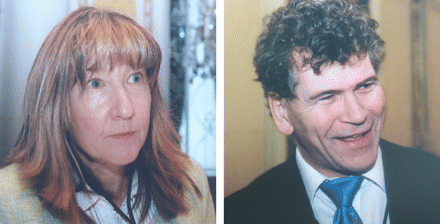Nature, Nurture, or Both Influenced Freud Descendent?
Abstract
If Sigmund Freud were alive today, he might be surprised and delighted to learn that his great-granddaughter Jane McAdam Freud is a sculptor. After all, he was enthralled by antique sculptures.
McAdam Freud's life and artistic career were the focus of a symposium at the American Psychoanalytic Association (APsaA) meeting in New York City in January. It was conducted by Warren Procci, M.D., a clinical professor of psychiatry at the University of California at Los Angeles and current president of the APsaA, and by Esther Dreifuss-Kattan, Ph.D., a Los Angeles analyst and art therapist. McAdam Freud was invited as the presidential guest and contributed to the discussion.

Jane McAdam Freud believes that some ancestral unconscious processes were at work in her as she tried to connect with Freud's sculptures through her own sculptures during her tenure as an artist in residence at the Freud Museum in London. She and her husband, Peter Henson, M.Sc. (right), bought property in Sigmund Freud's hometown both as a tribute to Freud and as a tribute to the townspeople, who look on Freud as a local hero.
"What can be more exciting than a symposium about the great-granddaughter of Freud on the 100th anniversary of our society?" Procci asked the analysts at the session.
In 1938, Sigmund Freud's consulting room in Vienna contained more than 2,000 ancient sculptures or other objects from Egypt, Greece, and Rome, Dreifuss-Kattan reported. He had bought the first one in 1896 and built up his collection over the years. It was a virtual museum, "dark and crowded," she said.
Twenty years later, in 1958, his great-granddaughter, McAdam Freud, was born in London, Dreifuss-Kattan noted. Today she is an acclaimed sculptor based in London. Her work can be found in the British Museum, Berlin Museum, National Museum of Copenhagen, and National Gallery of Greece, as well as the Carnegie Museum of Art and the Brooklyn Museum in the United States. She has had solo exhibitions in Australia, England, Scotland, Poland, Taiwan, and the United States. Her first solo exhibit in New York City, in the Sundaram Tagore gallery in Chelsea, closed on January 29.
Is there any link between Freud's passion for sculptures and McAdam Freud's passion for making them? Dreifuss-Kattan thinks there is. "Before she even saw Freud's sculpture collection in the Freud Museum in London, Jane was fascinated by art from antiquity," Dreifuss-Kattan said.
McAdam Freud also believes that there is a link between her ancestor's passion for sculptures and her own for creating them. "I wonder whether he was a frustrated artist?" she asked.
In any event, if one accepts that there is a link between Freud's fervor for sculptures and McAdam Freud's for creating them, a key question is: What is the explanation for the link?
One possibility is that Freud's zeal was passed down genetically to McAdam Freud. Freud's son Ernst was an architect. Ernst's son Lucian is a well-known painter. And Lucian's daughter Jane McAdam Freud is a sculptor.
Another possibility is that Freud's passion was transmitted to McAdam Freud through environmental influence. Although McAdam Freud never knew her great-grandfather, she did know her grandfather Ernst as a child and "adored him." She has also worked with her father, Lucian, who at age 88 still maintains a rigorous painting schedule.
And whether the passion for sculptures and sculpting was transmitted genetically or environmentally from Freud to McAdam Freud, it certainly looks as if the latter "was connected with the ancestral unconsciousness of her great-grandfather, grandfather, and father," Dreifuss-Kattan ventured.
McAdam Freud believes that some ancestral unconscious processes were likewise at work in her "trying to connect with Freud's sculptures through" her sculptures during her tenure as an artist in residence at the Freud Museum in London. During her stay there in 2006 and 2007, she explained, she filmed some of the sculptures collected by her great-grandfather, as well as some of her own, and then used a film-editing program to superimpose Freud's sculptures upon her own and to eventually merge them. The result was a 26-minute film, which she titled "Dead or Alive." She has since shown the film in various venues—including the New York Psychoanalytic Society, the German Psychoanalytic Society, the National Arts Club in New York City, and the Fourth International Psychoanalysis and Art Symposium in Florence, Italy.
McAdam Freud also showed a shortened version of this film at the APsaA meeting in January. Some in the audience noted uncanny similarities between some of Freud's sculptures and some of hers. These provocative resemblances made them wonder if some ancestral unconscious memory of the sculptures could have been passed down through the generations and thus have prompted McAdam Freud to create the sculptures that she did. Unfortunately, the session provided no answer to this speculation.



